Government of Canada
The federal government of Canada (French: Gouvernement fédéral du Canada) is the body responsible for the federal administration of Canada. In Canadian English, the term can mean either the collective set of institutions (the legislative, executive, and judicial branches) or specifically the Queen-in-Council (the executive, also called Her Majesty's Government[3][4][5]). In both senses, the current construct was established at Confederation through the Constitution Act, 1867—as a federal constitutional monarchy, wherein the Canadian Crown acts as the core, or "the most basic building block",[6] of its Westminster-style parliamentary democracy.[7] The Crown is thus the foundation of the executive, legislative, and judicial branches of Canadian government.[8][9][10] The monarch (currently Queen Elizabeth II) is personally represented by the Governor General of Canada (currently vacant, with Richard Wagner performing the duties of the office as the administrator of the government). The Prime Minister (currently Justin Trudeau) is the head of government who is invited by the Crown to form a government after securing the confidence of the House of Commons, which is typically determined through the election of enough members of a single political party in a federal election to provide a majority of seats in Parliament, forming a governing party. Further elements of governance are outlined in the rest of the Canadian Constitution, which includes written statutes in addition to court rulings, and unwritten conventions developed over centuries.[11]
| Federal Government | |
| Formation | July 1, 1867 |
|---|---|
| Founding document | Constitution Act, 1867 |
| Country | Canada |
| Website | canada |
| Crown | |
| Head of state (sovereign) | Monarch (Queen) |
| Vice-regal representative | Governor General |
| Seat | Rideau Hall |
| Legislative (Queen-in-Parliament) | |
| Legislature | Parliament |
| Meeting place | House of Commons: West Block[1] Senate: Senate of Canada Building[2] |
| Executive (Queen-in-Council) | |
| Head of government | Prime Minister |
| Main organ | Cabinet |
| Judicial (Queen-on-the-Bench) | |
| Court | Supreme Court of Canada (highest court) |
| Seat | Supreme Court Building, Ottawa |
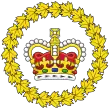 |
|---|
| This article is part of a series on the politics and government of Canada |
| Government (structure) |
|
|
Constitutionally, the Queen's Privy Council for Canada is the body that advises the sovereign or their representative on the exercise of executive power. This task is nearly exclusively carried out by a committee within the Queen's Privy Council known as the Cabinet who collectively set the government's policies and priorities for the country.[12] It is composed of ministers of the Crown and is chaired by the prime minister. The sovereign appoints the members of Cabinet on the advice of the Prime Minister who, by convention, are selected from the House of Commons or, less often, the Senate. During its term, the government must retain the confidence of the House of Commons, and certain important motions, such as the passing of the government's budget, are considered as confidence motions. Laws are formed by the passage of bills through Parliament, which are either sponsored by the government or individual members of Parliament. Once a bill has been approved by both the House of Commons and the Senate, royal assent is required to make the bill become law. The laws are then the responsibility of the government to oversee and enforce.
Definition
In Canadian English, the word government is used to refer both to the whole set of institutions that govern the country (just as in American English, whereas Britons would refer to such as state), and to the executive branch (just as in British English, whereas Americans would refer to such as administration). When the word is capitalized, as in "Government of Canada", it always refers to the executive branch.[13]
In press releases issued by federal departments, the government has sometimes been referred to as the current Prime Minister's government (e.g. the "Trudeau Government"). This terminology has been commonly employed in the media.[14] In late 2010, an informal instruction from the Office of the Prime Minister urged government departments to consistently use, in all department communications, such phrasing (i.e., "Harper Government," at the time) in place of "Government of Canada."[15] The same cabinet earlier directed its press department to use the phrase "Canada's New Government."[14]
Monarchy
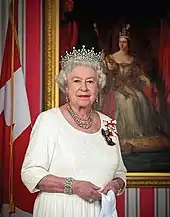
As per the Constitution Acts of 1867 and 1982, Canada is a constitutional monarchy, wherein the role of the reigning sovereign is both legal and practical, but not political.[16] The Crown is regarded as a corporation sole, with the monarch, vested as he or she is with all powers of state,[17] at the centre of a construct in which the power of the whole is shared by multiple institutions of government acting under the sovereign's authority.[18][19][20][21] The executive is thus formally referred to as Queen-in-Council; the legislature as the Queen-in-Parliament; and the courts as the Queen-on-the-Bench.[9]
Royal assent is required to enact laws. As part of the royal prerogative, the royal sign-manual gives authority to letters patent and orders in council, though the authority for these acts stems from the Canadian populace and,[22][23] within the conventional stipulations of a constitutional monarchy, the sovereign's direct participation in any of these areas of governance is limited.[24][25] The royal prerogative also includes summoning, proroguing, and dissolving parliament in order to call an election, and extends to foreign affairs, which include: the negotiation and ratification of treaties, alliances, international agreements, and declarations of war;[26] the accreditation of Canadian diplomats and receipt of foreign diplomats; and the issuance of passports.[27]
Though the person who is monarch of Canada (currently Queen Elizabeth II) is also the monarch of 15 other countries in the Commonwealth of Nations, he or she nevertheless reigns separately as King or Queen of Canada, an office that is "truly Canadian" and "totally independent from that of the queen of the United Kingdom and the other Commonwealth realms."[28][29] On the advice of the Canadian prime minister, the sovereign appoints a federal viceregal representative—i.e. the Governor General of Canada (currently vacant, with Richard Wagner performing the duties of the office as the administrator of the government)—who, since 1947, is permitted to exercise almost all of the monarch's royal prerogative, though there are some duties which must be specifically performed by the monarch themselves (such as assent of certain bills).
Executive branch
.jpg.webp)
The Government is defined by the constitution as the queen acting on the advice of her privy council.[3][30][31][32] However, the Privy Council—consisting mostly of former Members of Parliament, Chief Justices of the Supreme Court, and other elder statesmen—rarely meets in full. As the stipulations of responsible government require that those who directly advise the monarch and governor general on how to exercise the royal prerogative be accountable to the elected House of Commons (HOC), the day-to-day operation of government is guided only by a sub-group of the Privy Council made up of individuals who hold seats in parliament.[32] This body of senior ministers of the Crown is referred to as the Cabinet.
One of the main duties of the Crown is to ensure that a democratic government is always in place,[33] which includes the appointment of a prime minister to thereafter head the Cabinet.[34] Thus, the governor general must appoint as prime minister the person who holds the confidence of the House of Commons; who, in practice, is typically the leader of the political party that holds more seats than any other party in that chamber (currently the Liberal Party, led by Justin Trudeau). Should no particular party hold a majority in the HOC, the leader of one party—either the party with the most seats or one supported by other parties—will be called by the governor general to form a minority government. Once sworn in by the viceroy, the prime minister holds office until he or she resigns or is removed by the governor general, after either a motion of no confidence or his or her party's defeat in a general election.
The monarch and governor general typically follow the near-binding advice of their ministers. The royal prerogative, however, belongs to the Crown and not to any of the ministers,[21][35] who only rule "in trust" for the monarch and who must relinquish the Crown's power back to it upon losing the confidence of the commons,[36][37] whereupon a new government, which can hold the lower chamber's confidence, is installed by the governor general. The royal and viceroyal figures may unilaterally use these powers in exceptional constitutional crisis situations.[n 1] Politicians can sometimes try to use to their favour the complexity of the relationship between the monarch, viceroy, ministers, and parliament, as well as the public's general unfamiliarity with such.[n 2]
Legislative branch
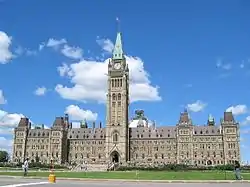
The Parliament of Canada—the bicameral national legislature located on Parliament Hill in the national capital of Ottawa—consists of the Queen-in-Parliament (normally represented by the governor general), the appointed Senate (i.e. upper house), and the elected House of Commons (i.e. lower house).[38] The governor general summons and appoints each of the 105 senators on the advice of the prime minister,[39] while the 338 members of the House of Commons (aka Members of Parliament, or MPs) are directly elected by Canadian citizens, with each member representing a single electoral district for a period mandated by law of no more than four years;[40] the constitution mandates a maximum of five years. Per democratic tradition, the House of Commons is the dominant branch of parliament and, as such, the Senate and Crown rarely oppose its will. The Senate, thus, reviews legislation from a less partisan standpoint.
As outlined in the Constitution Act, 1867, the governor general is responsible for summoning parliament in the Queen's name. A parliamentary session lasts until a prorogation, after which, without ceremony, both chambers of the legislature cease all legislative business until the governor general issues another royal proclamation calling for a new session to begin. A session begins with a "Speech from the throne," whereby the governor general or the monarch delivers the governing party's prepared speech of their intentions for the session. After a number of such sessions, each parliament comes to an end via dissolution. Since a general election will typically follow, the timing of a dissolution is usually politically motivated, with the prime minister selecting a moment most advantageous to his or her political party. However, the end of parliament may also be necessary if the majority of MPs revoke their confidence in the Prime Minister's ability to govern, such as through a vote of no-confidence or if the government's budget is voted down (a loss of supply). While the Canada Elections Act mandates that members of Parliament stand for election a minimum of every four-years, no parliament has ever been allowed to expire in such a fashion.
Judicial branch
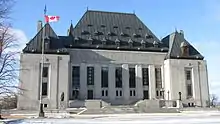
The sovereign is responsible for rendering justice for all her subjects, and is thus traditionally deemed the fount of justice.[41] However, she does not personally rule in judicial cases; instead the judicial functions of the royal prerogative are performed in trust and in the queen's name by officers of Her Majesty's courts.
The Supreme Court of Canada—the country's court of last resort—has nine justices appointed by the governor general on recommendation by the prime minister and led by the Chief Justice of Canada, and hears appeals from decisions rendered by the various appellate courts (provincial, territorial, and federal).
The Federal Court hears cases arising under certain areas of federal law,[42] and works in conjunction with the Tax Court of Canada.[43]
Federalism
The powers of the parliaments in Canada are limited by the Constitution, which divides legislative abilities between the federal and provincial governments. In general, the provincial legislatures may only pass laws relating to topics explicitly reserved for them by the constitution, such as education, provincial officers, municipal government, charitable institutions, and "matters of a merely local or private nature,"[44] whereas any matter not under the exclusive authority of the provincial legislatures is within the scope of the federal parliament's power.
Thus, the Federal Government alone can pass laws relating to, amongst other things, Canada's postal service, census, military, criminal law, navigation and shipping, fishing, currency, banking, weights and measures, bankruptcy, copyrights, patents, First Nations, and naturalization.[45]
In some cases, federal and provincial jurisdictions may be more vague. For instance, the federal parliament regulates marriage and divorce in general, while the solemnization of marriage is regulated only by provincial legislatures. Other examples include the powers of both the federal and provincial parliaments to impose taxes, borrow money, punish crimes, and regulate agriculture.
Political culture
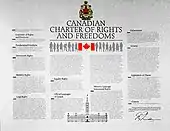
An emphasis on liberalism[46] and social justice has been a distinguishing element of Canada's political culture.[47] Individual rights, equality, and inclusiveness (i.e. a just society) have risen to the forefront of political and legal importance for most Canadians, as demonstrated through: support for the Canadian Charter of Rights and Freedoms;[48] a relatively-free economy; and social liberal attitudes toward women's rights, homosexuality, abortion rights, euthanasia, cannabis use, and other egalitarian movements.[49][50][51][48] Likewise, there is a sense of collective responsibility in Canadian political culture, as is demonstrated in general support for universal health care, multiculturalism, foreign aid, and other social programs.[52][53][54][55] Peace, order, and good government, alongside an implied bill of rights are founding principles of the Canadian government.[56][57]
At the federal level, Canada has been dominated by two relatively-centrist parties practicing "brokerage politics:"[lower-alpha 1] the centre-left Liberal Party of Canada and the centre-right Conservative Party of Canada (or its predecessors).[60][61][62][63][64][65] Regarding the Canadian political spectrum, the historically-predominant Liberals have positioned themselves more-or-less at the centre, with Conservatives sitting to their right and New Democrats occupying the further left.[66][67][68]
Smaller parties, such as the Green Party of Canada and the Quebec-nationalist Bloc Québécois, have also been able to exert their influence over the political process by representation at the federal level. Far-right and far-left politics, in terms of Canadian politics, have never been a prominent force in Canadian society.[69][70]
Polls have suggested that Canadians generally do not have a solid understanding of civics.[71] This has been theorised to be a result of less attention being given to the subject in provincial education curricula, beginning in the 1960s.[72] By 2008, a poll showed only 24% of respondents could name the queen as head of state.[73] Likewise, Senator Lowell Murray wrote five years earlier that "the Crown has become irrelevant to most Canadians' understanding of our system of Government."[74] As John Robson of the National Post opined in 2015:[75]
Intellectually, voters and commentators succumb to the mistaken notion that we elect 'governments' of prime ministers and cabinets with untrammelled authority, that indeed ideal 'democracy' consists precisely in this kind of plebiscitary autocracy.
See also
References
Notes
- Brokerage politics: A Canadian term for successful big tent parties that embody a pluralistic catch-all approach to appeal to the median Canadian voter ... adopting centrist policies and electoral coalitions to satisfy the short-term preferences of a majority of electors who are not located on the ideological fringe.[58][59]
- See 'Responsibilities' and Note 1 at Cabinet of Canada.
- It was said by Helen Forsey: "The inherent complexity and subtlety of this type of constitutional situation can make it hard for the general public to fully grasp the implications. That confusion gives an unscrupulous government plenty of opportunity to oversimplify and misrepresent, making much of the alleged conflict between popular democracy—supposedly embodied in the Prime Minister—and the constitutional mechanisms at the heart of responsible government, notably the 'reserve powers' of the Crown, which gets portrayed as illegitimate." As examples, she cited the campaign of William Lyon Mackenzie King following the King–Byng Affair of 1926 and Stephen Harper's comments during the 2008–2009 Canadian parliamentary dispute.[16]
Citations
- "An inside look at the new House of Commons". CBC News. Retrieved 29 March 2019.
- Cogley, Bridget. "Beaux-arts train station in Ottawa becomes temporary home for Canada's Senate". Dezeen. Retrieved 29 March 2019.
- MacLeod, Kevin S. 2008. A Crown of Maples (1st ed.). Ottawa: Queen's Printer for Canada. p. 18, ISBN 978-0-662-46012-1. Retrieved 21 June 2009.
- Government of Canada. "Speech From the Throne > Frequently Asked Questions". Queen's Printer for Canada. Archived from the original on 19 October 2013. Retrieved 4 June 2010.
- Grand Chief's Office, Treaty 3 Between Her Majesty the Queen and the Saulteaux Tribe of the Ojibway Indians at the Northwest Angle on the Lake of the Woods With Adhesions, The Grand Council of Treaty #3, archived from the original on 4 April 2010, retrieved 4 June 2010
- Department of Canadian Heritage (February 2009), Canadian Heritage Portfolio (PDF) (2 ed.), Ottawa: Queen's Printer for Canada, p. 3, ISBN 978-1-100-11529-0, archived from the original (PDF) on 11 June 2011, retrieved 5 July 2009
- Coyne, Andrew (13 November 2009). "Defending the royals". Maclean's. ISSN 0024-9262. Retrieved 17 November 2009.
- Victoria (1867), Constitution Act, 1867, III.15, Westminster: Queen's Printer (published 29 March 1867), retrieved 15 January 2009
- MacLeod 2008, p. 17
- Department of Canadian Heritage 2009, p. 4
- Brooks, Stephen Farper (2007). Canadian Democracy: An Introduction (5 ed.). Don Mills: Oxford University Press. p. 126. ISBN 978-0-19-543103-2.
- Office, Privy Council (21 February 2018). "About Cabinet". aem. Retrieved 15 April 2020.
- "Overview of the Canadian Parliamentary System | Our Country, Our Parliament". lop.parl.ca. Retrieved 11 September 2020.
- Cheadle, Bruce (3 March 2011), "Tories re-brand government in Stephen Harper's name", The Globe and Mail, retrieved 26 April 2011
- "Tories defend use of 'Harper Government'". CTV News. Bell Media. 7 March 2011. Retrieved 9 May 2011.
- Forsey, Helen (1 October 2010). "As David Johnson Enters Rideau Hall ..." The Monitor. Retrieved 23 January 2011.
- Privy Council Office (2008). Accountable Government: A Guide for Ministers and Ministers of State – 2008. Ottawa: Queen's Printer for Canada. p. 45. ISBN 978-1-100-11096-7. Archived from the original on 18 March 2010. Retrieved 17 May 2009.
- Smith, David E. 10 June 2010. "The Crown and the Constitution: Sustaining Democracy?" Ottawa: Conference on the Crown. p. 6. – via Queen's University. Archived from the original on 17 June 2010. Retrieved 22 May 2020.
- Bosc, Marc, and André Gagnon, eds. 2017. "Parliamentary Institutions." Ch. 1 in House of Commons Procedure and Practice (3rd ed.). Ottawa: House of Commons Table Research Branch. s. Institutional Framework. Retrieved 22 May 2020.
- Table Research Branch of the House of Commons. "The Canadian Parliamentary System." Our Procedure. Ottawa. Retrieved 22 May 2020.
- Cox, Noel (September 2002). "Black v Chrétien: Suing a Minister of the Crown for Abuse of Power, Misfeasance in Public Office and Negligence". Murdoch University Electronic Journal of Law. 9 (3): 12. Retrieved 17 May 2009.
- Forsey, Eugene (2005). How Canadians Govern Themselves (PDF) (6 ed.). Ottawa: Queen's Printer for Canada. p. 1. ISBN 978-0-662-39689-5. Archived from the original (PDF) on 25 March 2009. Retrieved 14 May 2008.
- Marleau, Robert; Montpetit, Camille (2000). "House of Commons > 1. Parliamentary Institutions". Queen's Printer for Canada. Archived from the original on 28 August 2011. Retrieved 28 September 2009.
- MacLeod 2008, p. 16
- Russell, Peter (1983), "Bold Statecraft, Questionable Jurisprudence", in Banting, Keith G.; Simeon, Richard (eds.), And no one cheered: federalism, democracy, and the Constitution Act, Toronto: Taylor & Francis, p. 217, ISBN 978-0-458-95950-1
- Brode, Patrick (1 May 2006), "War power and the Royal Prerogative", Law Times, Thomson Reuters Canada, archived from the original on 22 November 2012, retrieved 22 October 2012
- Elizabeth II (2006). "Canadian Passport Order" (PDF). 4.4. Ottawa: Queen's Printer for Canada (published 28 June 2006). Archived from the original (PDF) on 26 March 2009. Retrieved 19 May 2009. Cite journal requires
|journal=(help) - Crown of Maples- Constitutional Monarchy in Canada (2008 ed.). Queen's Printer for Canada. 2008. pp. 5, 12, 20, 40, 49. ISBN 978-0-662-46012-1. Retrieved 2 May 2012.
- "The Queen and Canada: History and present Government". The Royal Household. Retrieved 2 May 2012.
- Wrong, Humphrey Hume. 10 November 1952. "Relations With the United States [Telegram 219]." Documents on Canadian External Relations 18(867): Ch. 8. Ottawa: Department of Foreign Affairs and International Trade Canada. Archived from the original on 23 November 2011. Retrieved 22 May 2020.
- Victoria 1867, III.9 & 11
- Marleau & Montpetit 2000, The Executive
- Jackson, Michael D. October 2009. "The Senior Realms of the Queen" (book review & commentary). Canadian Monarchist News 39(30):9–12. Archived from the original on 29 December 2009. Retrieved 22 May 2020. p. 9. Reviewed work: Boyce, Peter. 2008. The Queen's Other Realms: The Crown and its Legacy in Australia, Canada and New Zealand. ISBN 9781862877009. Sydney, AU: Federation Press.
- Office of the Governor General of Canada. "Media > Fact Sheets > The Swearing-In of a New Ministry". Queen's Printer for Canada. Archived from the original on 9 October 2006. Retrieved 18 May 2009.
- Neitsch, Alfred Thomas. 2007. "A Tradition of Vigilance: The Role of Lieutenant Governor in Alberta." Canadian Parliamentary Review 30(4):19–28. Retrieved 22 May 2020. p. 23.
- MacLeod 2008, p. 8
- Tidridge, Nathan (2011). Canada's Constitutional Monarchy: An Introduction to Our Form of Government. Dundurn. p. 65. ISBN 978-1-4597-0084-0.
- Victoria 1867, IV.17
- Victoria 1867, IV.24
- Elizabeth II (31 May 2000), Canada Elections Act, 56.1.2, Ottawa: Queen's Printer for Canada, retrieved 20 November 2009
- "Debates of the Senate, 2nd Session". Parliamentary Debates (Hansard). 138(29). 36th Parliament: Senate. 17 February 2000. col. 1500–10. Archived from the original on 4 September 2007. Retrieved 21 November 2009.CS1 maint: location (link)
- Federal Court. "About the Court > Jurisdiction". Queen's Printer for Canada. Archived from the original on 29 September 2011. Retrieved 20 November 2009.
- Elizabeth II (27 March 2002), Courts Administration Service Act, 2.a, Ottawa: Queen's Printer for Canada, retrieved 18 November 2009
- Victoria 1867, VI.92
- Victoria 1867, VI.91
- Anne Westhues; Brian Wharf (2014). Canadian Social Policy: Issues and Perspectives. Wilfrid Laurier Univ. Press. pp. 10–11. ISBN 978-1-55458-409-3.
- Katherine Fierlbeck (2006). Political Thought in Canada: An Intellectual History. University of Toronto Press. p. 87. ISBN 978-1-55111-711-9.
- "Examples of Charter-related cases - Canada's System of Justice". Department of Justice - Government of Canada. 2018.
- Rand Dyck (2011). Canadian Politics. Cengage Learning. p. 88. ISBN 978-0-17-650343-7. Archived from the original on 12 April 2016.
- Stephen L. Newman (2012). Constitutional Politics in Canada and the United States. SUNY Press. p. 203. ISBN 978-0-7914-8584-2. Archived from the original on 12 April 2016.
- Shibao Guo; Lloyd Wong (2015). Revisiting Multiculturalism in Canada: Theories, Policies and Debates. University of Calgary. p. 317. ISBN 978-94-6300-208-0. Archived from the original on 13 April 2016.
- Bricker, Darrell; Wright, John (2005). What Canadians think about almost everything. Doubleday Canada. pp. 8–28. ISBN 978-0-385-65985-7.
- Nanos Research (October 2016). "Exploring Canadian values" (PDF). Archived from the original (PDF) on 5 April 2017. Retrieved 1 February 2017.
- "A literature review of Public Opinion Research on Canadian attitudes towards multiculturalism and immigration, 2006–2009". Government of Canada. 2011. Archived from the original on 22 December 2015. Retrieved 18 December 2015.
- "Focus Canada (Final Report)" (PDF). The Environics Institute. Queen's University. 2010. p. 4 (PDF page 8). Archived from the original (PDF) on 4 February 2016. Retrieved 12 December 2015.
- John Dixon; Robert P. Scheurell (17 March 2016). Social Welfare in Developed Market Countries. Routledge. p. 48. ISBN 978-1-317-36677-5.
- Janina Boughey (2017). Human Rights and Judicial Review in Australia and Canada: The Newest Despotism?. Bloomsbury Publishing. p. 105. ISBN 978-1-5099-0788-5.
- Alex Marland; Thierry Giasson; Jennifer Lees-Marshment (2012). Political Marketing in Canada. UBC Press. p. 257. ISBN 978-0-7748-2231-2.
- John Courtney; David Smith (2010). The Oxford Handbook of Canadian Politics. OUP USA. p. 195. ISBN 978-0-19-533535-4.
- Brooks, Stephen (2004). Canadian Democracy: An Introduction. Oxford University Press. p. 265. ISBN 978-0-19-541806-4.
Two historically dominant political parties have avoided ideological appeals in favour of a flexible centrist style of politics that is often labelled brokerage politics
- Johnson, David (2016). Thinking Government: Public Administration and Politics in Canada, Fourth Edition. University of Toronto Press. pp. 13–23. ISBN 978-1-4426-3521-0.
...most Canadian governments, especially at the federal level, have taken a moderate, centrist approach to decision making, seeking to balance growth, stability, and governmental efficiency and economy...
- Smith, Miriam (2014). Group Politics and Social Movements in Canada: Second Edition. University of Toronto Press. p. 17. ISBN 978-1-4426-0695-1.
Canada's party system has long been described as a “brokerage system” in which the leading parties (Liberal and Conservative) follow strategies that appeal across major social cleavages in an effort to defuse potential tensions.
- Elections Canada (2018). "Plurality-Majority Electoral Systems: A Review". Elections Canada.
First Past the Post in Canada has favoured broadly-based, accommodative, centrist parties...
- Cochran, Christopher (2010). "Left/Right Ideology and Canadian Politics". Canadian Journal of Political Science. 43 (3): 583–605. doi:10.1017/S0008423910000624. JSTOR 40983510.
- Baumer, Donald C., and Howard J. Gold (2015). Parties, Polarization and Democracy in the United States. Taylor & Francis. pp. 152–. ISBN 978-1-317-25478-2.CS1 maint: multiple names: authors list (link)
- Amanda Bittner; Royce Koop (1 March 2013). Parties, Elections, and the Future of Canadian Politics. UBC Press. pp. 300–. ISBN 978-0-7748-2411-8.
- Rodney P. Carlisle (2005). Encyclopedia of Politics: The Left and the Right. SAGE Publications. p. 274. ISBN 978-1-4522-6531-5.
- Geoffrey Evans; Nan Dirk de Graaf (2013). Political Choice Matters: Explaining the Strength of Class and Religious Cleavages in Cross-National Perspective. OUP Oxford. pp. 166–167. ISBN 978-0-19-966399-6.
- Ambrose, Emma; Mudde, Cas (2015). "Canadian Multiculturalism and the Absence of the Far Right". Nationalism and Ethnic Politics. 21 (2): 213–236. doi:10.1080/13537113.2015.1032033. S2CID 145773856.
- Taub, Amanda (2017). "Canada's Secret to Resisting the West's Populist Wave". The New York Times.
- Jackson, Michael D. (2013), The Crown and Canadian Federalism, Dundurn Press, p. 11, ISBN 978-1-4597-0989-8, retrieved 6 June 2014
- Tidridge, Nathan (2011), Canada's Constitutional Monarchy: An Introduction to Our Form of Government, Toronto: Dundurn Press, p. 19, ISBN 978-1-4597-0084-0
- "In the Wake of Constitutional Crisis: New Survey Demonstrates that Canadians Lack Basic Understanding of Our Country's Parliamentary System" (PDF). Toronto: Ipsos Reid. 15 December 2008: 1. Retrieved 18 May 2010. Cite journal requires
|journal=(help) - Murray, Lowell. 2003. 'Which Criticisms are Founded?' Protecting Canadian Democracy: The Senate You Never Knew, edited by S. Joyal. Montreal: McGill-Queen's University Press. p. 136.
- Robson, John (2 November 2015). "Trudeau's menacing promise of electoral reform". National Post. Postmedia. Retrieved 5 November 2015.
Further reading
- Bourinot, John George (2008), Flint, Thomas Barnard (ed.), Parliamentary Procedure and Practice in the Dominion of Canada (4th ed.), Lawbook Exchange, ISBN 978-1-58477-881-3
- Dawson, R. MacGregor; Dawson, W. F. (1989). Ward, Norman (ed.). Democratic Government in Canada. Toronto: University of Toronto Press. p. 17. ISBN 978-0-8020-6703-6. Retrieved 14 January 2011.
Democratic Government in Canada.
- Johnson, David (2006), Thinking government: public sector management in Canada (2nd ed.), Broadview Press, ISBN 978-1-55111-779-9
- Hale, Geoffrey (2006), Uneasy partnership: the politics of business and government in Canada, Broadview Press, ISBN 978-1-55111-504-7
- Malcolmson, Patrick; Myers, Richard (2009), The Canadian Regime: An Introduction to Parliamentary Government in Canada (4th ed.), University of Toronto Press, ISBN 978-1-4426-0047-8
- Morton, Frederick Lee (2002), Law, politics, and the judicial process in Canada, Frederick Lee, ISBN 978-1-55238-046-8
- Roy, Jeffrey (2006), E-government in Canada: transformation for the digital age, University of Ottawa Press, ISBN 978-0-7766-0617-0
- — (2007), Business and government in Canada, University of Ottawa Press, ISBN 978-0-7766-0658-3
